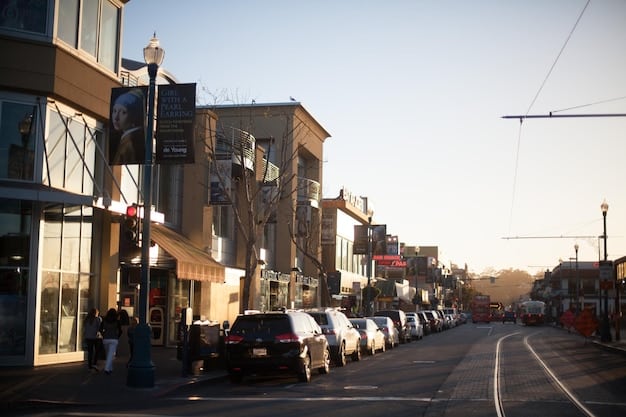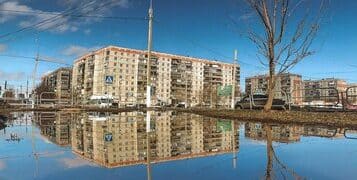Long-Term Effects of Remote Work on US Social Life

The long-term effects of remote work on US social interaction and community engagement include shifts in urban density, altered social habits, potential erosion of community bonds, and new forms of digital interaction, impacting both individual well-being and societal structures.
Has remote work reshaped the American social landscape? The shift to remote work, accelerated by recent global events, is far more than just a change in where we work; it’s a seismic shift in how we interact, connect, and engage with our communities. Let’s delve into what are the long-term effects of remote work on US social interaction and community engagement.
The Urban Exodus and Its Social Impact
The rise of remote work has triggered a noticeable migration trend in the US. People are moving away from expensive urban centers to more affordable suburban or rural areas. This shift has significant implications for social interaction and community engagement.
The Emptying City Centers
As more companies adopt remote work policies, the need for large office spaces diminishes. This can lead to a decrease in foot traffic in city centers, affecting local businesses and the overall vibrancy of urban social life.
The Rise of Suburban Communities
The influx of remote workers into suburban areas can revitalize these communities, but it also poses challenges. Integrating newcomers and maintaining a sense of community can require proactive efforts.
- Increased demand for local amenities and services.
- Potential strain on existing infrastructure and resources.
- The need for community-building initiatives to foster social connections.

In conclusion, the urban exodus driven by remote work is reshaping the social dynamics of both urban and suburban areas. Understanding and addressing these changes is crucial for fostering resilient and connected communities.
Changes in Social Habits and Networking
Remote work has undeniably altered our social habits and networking patterns. With less time spent commuting and in traditional office settings, individuals are finding new ways to connect and build relationships.
The Decline of Water Cooler Moments
One of the most apparent changes is the decline of spontaneous, informal interactions that occur in a physical workplace. These “water cooler moments” often play a crucial role in building camaraderie and fostering a sense of belonging.
The Rise of Digital Socializing
Remote workers are increasingly relying on digital platforms to maintain social connections and network with colleagues and industry peers. This includes virtual meetings, online communities, and social media.
- Increased use of video conferencing for social gatherings.
- Growth of online communities and professional networks.
- Challenges in building deeper connections through digital channels.
Adapting to these changes in social habits requires conscious effort and a willingness to embrace new forms of interaction. Finding a balance between digital and in-person connections is key to maintaining a healthy social life.

The Impact on Community Engagement
Community engagement, the lifeblood of a healthy society, faces both challenges and opportunities in the age of remote work. Understanding these dynamics is essential for building strong and vibrant communities.
Decreased Participation in Local Events
With fewer people physically present in their communities during the day, there may be a decline in participation in local events, volunteer activities, and civic organizations.
New Avenues for Civic Participation
Remote work can also create new opportunities for civic participation. Individuals with flexible schedules may have more time to engage in online activism, contribute to virtual community projects, or participate in remote government meetings.
- Increased engagement in online activism and advocacy.
- Development of virtual community projects and initiatives.
- Challenges in ensuring equitable access to digital participation.
To foster community engagement in the remote work era, communities need to adapt their strategies and embrace digital tools. This includes creating online platforms for communication, organizing virtual events, and promoting flexible volunteer opportunities.
The Blurring Lines Between Work and Personal Life
One of the most significant long-term effects of remote work is the blurring of boundaries between work and personal life. This can have profound implications for social interaction and overall well-being.
Increased Isolation and Loneliness
The lack of physical separation between work and home can lead to increased feelings of isolation and loneliness, particularly for individuals who live alone or lack strong social support systems.
Impact on Family Dynamics
Remote work can also affect family dynamics, creating both opportunities and challenges. While it may allow for more quality time with family members, it can also lead to increased conflict and stress if boundaries are not clearly defined.
The Importance of Boundaries
Establishing clear boundaries between work and personal life is crucial for mitigating the negative social effects of remote work. This includes setting dedicated work hours, creating a separate workspace, and prioritizing social activities.
Addressing the blurring lines between work and personal life requires a holistic approach that considers individual needs, family dynamics, and community support systems. Promoting work-life balance and fostering social connections are essential for ensuring the well-being of remote workers.
The Future of Social Spaces
As remote work becomes more prevalent, the nature of social spaces is evolving. Traditional gathering places are adapting to meet the changing needs of remote workers, and new types of spaces are emerging.
The Evolution of Co-Working Spaces
Co-working spaces are becoming increasingly popular as hubs for remote workers to connect, collaborate, and socialize. These spaces offer a sense of community and provide opportunities for networking and professional development.
The Redesign of Public Spaces
Cities and communities are also redesigning public spaces to better accommodate remote workers. This includes creating outdoor workspaces, providing free Wi-Fi access, and developing community centers that offer a range of social and recreational activities.
- Increased investment in public Wi-Fi infrastructure.
- Development of outdoor workspaces and community gardens.
- Creation of multi-purpose community centers that cater to remote workers.
The future of social spaces involves creating flexible, inclusive, and accessible environments that foster social interaction and community engagement. By adapting to the changing needs of remote workers, communities can ensure that these spaces remain vibrant and relevant.
The Digital Divide and Social Inequality
It’s vital to recognize that the shift to remote work is not experienced equally across all segments of society. The digital divide, which refers to the gap between those who have access to technology and those who do not, can exacerbate social inequalities and limit opportunities for certain groups.
Unequal Access to Technology
Individuals and communities with limited access to reliable internet service, computers, and digital literacy skills are at a disadvantage in the remote work era. This can hinder their ability to participate in online social activities, access educational resources, and engage in remote work opportunities.
The Impact on Low-Wage Workers
Many low-wage workers, particularly those in the service and hospitality industries, cannot perform their jobs remotely. These individuals may face job losses or reduced work hours as a result of the shift to remote work, further widening the gap between the haves and have-nots.
Bridging the digital divide requires targeted interventions that address the root causes of social inequality. This includes investing in affordable internet access, providing digital literacy training, and creating job opportunities for low-wage workers in the remote work economy.
| Key Point | Brief Description |
|---|---|
| 🏘️ Urban Exodus | Shift from cities impacts urban centers. |
| 💻 Digital Socializing | Reliance on virtual platforms increases. |
| 🤝 Community Engagement | Participation shifts to online activities. |
| 🌐 Digital Divide | Unequal tech access impacts opportunities. |
FAQ
▼
Remote work leads to decreased urban density as people move to suburban or rural areas, reducing foot traffic and impacting local businesses in city centers.
▼
Digital social gatherings, online communities, and virtual networking events have become more prevalent, providing remote workers with new ways to connect and socialize.
▼
Communities can create online platforms, organize virtual events, and offer flexible volunteer opportunities to foster community engagement among remote workers.
▼
The digital divide exacerbates social inequalities by limiting access to technology for some, hindering their ability to participate in online social activities and remote work opportunities.
▼
The decrease in spontaneous office interactions may erode camaraderie and a sense of belonging, affecting team cohesion and informal knowledge sharing among colleagues.
Conclusion
In conclusion, the long-term effects of remote work on US social interaction and community engagement are multifaceted and far-reaching. As we navigate this evolving landscape, it’s crucial to address the challenges, embrace the opportunities, and work towards creating a more inclusive and connected society for all.





